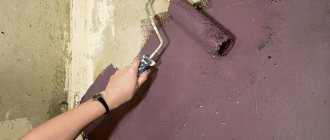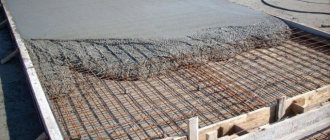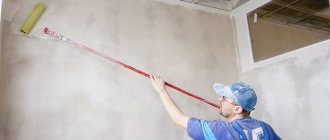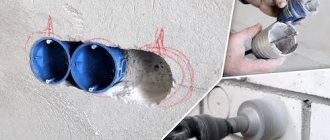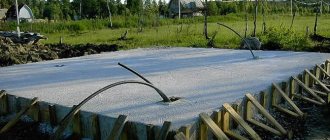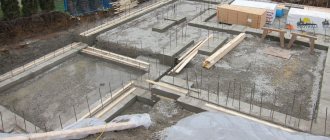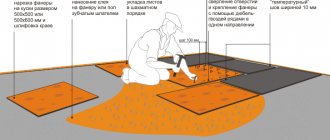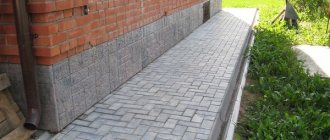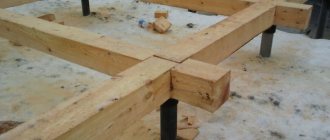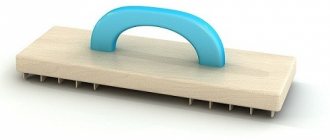If you need to carry out concrete work in Dmitrov, it offers qualified services for these types of work. Concrete work under a contract is a convenient and reliable form of cooperation, which allows our customers not to worry about the quality of services and excellent results of the events.
| № | Job title | unit. | price, rub. |
| Concrete works: | |||
| 1 | Concrete foundation preparation device | cubic meters | 2500 |
| 2 | Installation of vertical formwork | sq.m | 120 |
| 3 | Dismantling vertical formwork | sq.m | 25 |
| 4 | Installation of horizontal formwork | sq.m | 170 |
| 5 | Dismantling horizontal formwork | sq.m | 28 |
| 6 | Construction of a flat reinforcement frame | T | 4200 |
| 7 | Construction of a spatial reinforcement frame | T | 10200 |
| 8 | Arrangement of reinforcement frame for staircases | T | 14500 |
| 9 | Laying concrete in formwork | cubic meters | 800 |
| 10 | Installation of foundation blocks | cubic meters | 450 |
Many years of experience and convincing professionalism of our employees allow us to carry out concrete work of any complexity with excellent results. The performance characteristics of the house depend on the quality of concrete work and formwork, made in strict accordance with technology:
- strength;
- sustainability;
- soundproofing;
- thermal insulation.
The cost of concrete work for 1 m3 depends on the filler, the complexity of the delivery time of the mixture and the choice of formwork materials. The calculation is made transparently in accordance with fixed tariffs.
Concrete work in the construction of structures for various purposes
Turnkey concrete works are carried out for various tasks. Let's name the most popular structures:
- Concrete work for the foundation - the price is determined depending on the method: strip or monolithic. The reliability of the foundation and the quality of the building mixture determine the durability of the entire structure. Having entrusted the installation of the foundation of the house to an amateur, you will subsequently have to correct defects such as cracks or chips. There are also risks of uneven and excessive shrinkage of the structure.
- Columns increase the rigidity and reliability of the entire structure, but only if the implementation is carried out in accordance with the rules. Unreliable columns can pose a danger to the stability of the structure and the health of the building's occupants. Technological construction of columns will speed up and reduce the cost of building construction.
- Floors are in demand in both residential and industrial premises. A concrete floor, provided that the mixture is professionally prepared, properly leveled and dried, is very reliable and convenient. Concrete work (price per m3) for floor screed is a budget and reliable solution.
- The blind area around the house is a structure with a protective and decorative function. Blind areas protect the foundation from excessive moisture, which helps to increase the life of the house.
The price list for concrete work (foundation, columns and other structures) will inform you in detail about the cost of all work and help plan the construction budget.
Correct reinforcement of the corners of a shallow strip foundation
The need to reinforce a strip foundation on ordinary soil or on loam in the corners is explained by the properties of building materials.
Concrete itself is not flexible and strong enough to easily withstand tension and other loads operating in different parts of the foundation, especially when it comes to uneven loads (caused by soil heaving, temperature changes, moisture, etc.). During deformation, zones of tension and compression appear in a concrete structure. And while concrete can survive compression, tension destroys it. In order to counteract this load, reinforcement is needed: a metal frame is placed inside the concrete structure, which absorbs tensile loads and significantly strengthens the material, extending the life of the entire structure.
The angle of the tape and the junction points are the most important points of the structure; greater pressure is exerted on them compared to the longitudinal parts, so special attention should be paid to their strengthening.
Proper reinforcement of important structural elements plays a very important role in ensuring the long life and performance of the entire structure. Therefore, you can do everything yourself only after carefully studying the parameters and standards, paying attention to each stage. Otherwise, it is better to leave the work to professionals.
Primary requirements:
- Reinforcement rods in the corners must be knitted while maintaining a distance between the rods of 50-80 centimeters.
- The distance between the longitudinal reinforcing belts is 50 centimeters, their number is calculated in each individual case.
- On both sides of each corner, 3-4 belts are installed transversely, with a step of 0.5 from the main one. Do the same in the corners.
- The diameter of the working reinforcement should be 1-2 centimeters, the diameter of additional rods can be 4-10 millimeters.
- Strict adherence to the sequence of work: first, vertical rods are driven into the ground, then horizontal rods are welded to the vertical rods at the top and bottom.
- It is advisable not to make joints in the corners, it is necessary to use bent rods, on straight sections of joints it is better not to make them at all, but if a joint is made, then only by the overlap method with the following parameters: 50 rod diameters for M200 concrete, 40 for M250, 35 for M300 . Vertical joining of longitudinal reinforcement is possible only with a spacing of at least 60 centimeters or 1.5 times the total overlap length.
- The main methods of joining materials: welding, overlap joining, using mechanical devices. Knitting of reinforcement at the corners of the strip foundation is carried out exclusively using special wire.
- To form a protective concrete layer at least 5 centimeters thick after pouring, special devices are used - “frogs” or “chairs” are installed on the bottom, and “stars” on the sides.
- The frame is placed at a distance of 5 centimeters from the foundation.
- Connections are made using reinforcement bent at 90 degrees, without welding. Fasten on straight sections with wire.
- Be sure to lay a cushion of sand and gravel at the bottom of the trench, which will ensure sufficient strength of the base.
The maximum stress is usually concentrated in the corner and different layers of the frame experience different loads. And the main task of the reinforcement is to make sure that the steel rods absorb these loads evenly, completely taking them over themselves. And if the metal rods are connected incorrectly or with breaks, then the foundation will simply turn into a set of parts, each of which by itself will not give any benefit, and the concrete will quickly delaminate and become covered with chips and cracks.
Therefore, all work must be performed correctly, avoiding simple crosses of the ends of the rods in the indicated places, as can often be found in construction practice.
First, frame drawings are made, where the main values are written down, important parameters and indicators are calculated, and the required minimum reinforcement in the calculation is determined. Then they implement the task.
Reinforcement scheme:
- Fix the vertical rods at intervals of 60 centimeters.
- Using knitting wire, fasten the horizontal power rods at the top and bottom of the contour at the places where they intersect.
- Strengthen the areas located in the middle of the spans with additional rods.
- The reinforcement is simply crossed in the corners, secured with wire. This is wrong, although the scheme is quite common.
- In the corners the rods are bent, but not anchored. Thus, SP 50-101-2004 says that prefabricated monolithic and monolithic foundations must be rigidly connected by cross strips. A connection with a regular crosshair means a break at the bend, which will not provide sufficient rigidity. In places where they overlap, the rods can be connected only in the indicated ways: mechanically with couplings, welding, without welding (overlapping corrugated rods with straight ends, with transverse or welded rods, with bends at the ends).
- Using only one strapping circuit.
- Using two circuits without properly securing them together.
- Lack of structural connection between the reinforcement frame and the base.
- In the corners of the structure, the rods were connected by welding, ignoring other joining methods.
Knitting of reinforcement in the corners of the strip foundation is carried out using the following means: grinder, rods, gas or electric welding machine. First, everything is calculated - the number of rods, their diameter, and knitting methods depend on the calculation. Particular attention is paid to strengthening the sole, making the structure on site.
Two contours are welded, one with an indentation of 5 centimeters from the outer perimeter of the foundation trench. The second is placed at the same distance from the inner edge. The weld seams should not be in the corners. The reinforcement is bent at right angles, the bending points are heated, welding is used only where the loads are relatively low.
Next, the structure is lowered into the trench, and vertical rods are installed in the corners. The pins are driven deep into the ground, the contours are welded to the vertical posts. The upper part of the foundation should also be made of two contours.
Before tying reinforcement, it is necessary to study the types of tying. Simple connections are not suitable in this case. It is imperative to use bent elements that will continue the longitudinal rods of the frame and protrude beyond the corner by 60-70 centimeters. If the length of the rod is not enough, you can fasten it with clamps with sides equal to at least 50 diameters of the reinforcement used.
- The distance between vertical rods up to 20 millimeters should be equal to 50-80 centimeters.
- You need to use working steel rods with a diameter of 1-2 centimeters, additional elements must have a cross-section of at least 4-10 millimeters.
- It is advisable to use non-metal pads that will fix the frame at the required distance from the ground and nearby structures.
- Horizontally located rods are mounted exclusively in a bent form.
- You cannot connect end to end.
Knitting reinforcement for strip foundations
Before tying reinforcement for a strip foundation, it is necessary to take into account some mistakes that developers make:
- Straight rods in the corners are connected using overlaps;
- The frame stands on a concrete base on a vertical rod;
- The number of reinforced rods in a concrete structure is no more than 0.2%;
- There are no side protective layers; the rods may touch some areas of the formwork.
When reinforcing a strip foundation, you need to take into account some of its features:
- During concreting, it is necessary to connect the reinforcement cages inside the formwork using rods, clamps and anchors.
- The reinforcement for the strip foundation is knitted before the panels begin to be installed, because it is quite difficult to get inside.
- The frame is manufactured directly at the construction site, placed on the formwork, and then reinforced with an L-shaped or U-shaped anchor inside.
- Thanks to the footing, the minimum size of the protective layers of concrete near the base of the structure is reduced by half, and to create a lower protective layer, you need to use a special plastic stand called a glass.
- If composite reinforcement is knitted, then the rods need to be extended specifically in order to make a small overlap of 21 to 26 cm in diameter.
- The frame should not be laid on the bottom of stones, bricks, or scraps of reinforcement; the lining can only be made of plastic or concrete.
- When knitting reinforcement for a strip foundation, you must ensure that the connections of the rods overlap and not next to each other, but scattered.
Where to start with reinforcement
Work on laying the foundation begins with marking and preparing the soil. Concrete can be poured directly into the soil (in dense soils, trenches are dug according to the size of the foundation being poured) or into formwork (the recommended option). Before pouring concrete, it is necessary to carefully reinforce the foundation strip. You can do this yourself. Before starting work, draw up a reinforcement diagram - this will allow you to accurately calculate the required amount of material.
For private construction, ribbed reinforcement with a diameter of 12-18 mm of class A3 is used. If the height of the foundation is more than 150 mm, the rods are installed at the top and bottom, connected to each other with smooth class A1 wire with a diameter of 6-8 mm. As a result, a structure is formed, the cross-section of which is a square or quadrangle with right angles, the corners of which are longitudinally located reinforcement 12-18 mm, and the walls are transverse ligaments made of smooth rods 6-8 mm.
We suggest you read: How to build a bathhouse correctly - All about the bathhouse
For low-rise construction, reinforcement with a diameter of 12-14 mm is sufficient. Thicker rods will only increase the cost of construction; using them does not make much sense.
Transverse ligaments are installed on the outside of the structure and give rigidity to the reinforcement frame. The distances between the rods are indicated in the SNiP instructions 52-01-2003.
The distance between the longitudinal reinforcement rods should be “no more than twice the height of the element’s section and no more than 400 mm,” and “the pitch of the transverse reinforcement should be no more than half the working height of the element’s section and no more than 300 mm.”
Saving on material is inappropriate, but increasing its amount will not increase the strength of the foundation. The main load is taken by the longitudinal lashes of the frame, with the upper ones working in compression and the lower ones in tension.
Concrete floors with Elastoconcrete additives
has developed and produces “Elastobeton” concrete additives, which not only improve the properties of concrete screed, but also can significantly reduce its cost.
"Elastoconcrete" - complex additives for concrete - advantages.
- Increases the strength of concrete by 70-110% and reduces shrinkage by 60-70%. Increasing strength makes it possible to reduce the thickness of the screed under the same operating loads, and reducing shrinkage allows you to eliminate reinforcement when installing a concrete floor on monolithic foundations. In addition to compressive strength, impact strength and wear resistance are increased. In most cases, additives for Elastobeton concrete are introduced into additive-free concrete B22.5 (M300), as a result of which the concrete floor gains strength M500-M550 on the 28th day of normal hardening. The strength of non-additive concrete B25 (M350) increases to M700-M750.
- Reducing the thickness and eliminating reinforcement can significantly reduce the price of a concrete floor, both in terms of materials (100 RUR/m² or more) and in terms of work (50 RUR/m² or more).
- The period for putting floors into operation is reduced by 3-4 times - from 28 to 7-8 days. The curing time of concrete before applying polymer floors is reduced to 14 days, and Elakor polyurethane impregnations are reduced to 6-7 days.
The construction of concrete floors using the concrete additive Elastoconcrete occurs using standard concrete laying technologies. This improves the workability of concrete, which greatly simplifies concrete work.
How to connect reinforcement
Can fittings be welded? It is better not to use welding - it weakens the material. Only fittings marked “C” can be welded. But without experience in welding the frame, you can cut the steel, overheat it - all this will negatively affect the strength of the reinforcement grid.
For tying, a special hook is used, which is threaded through a loop of wire and twisted so that the wire pulls the parts being tied together, pressing them tightly together. The wire should be twisted with force so that it covers both rods to be tied with force. But there is no need to make excessive efforts - you will break the wire. Usually, several attempts are enough to understand with what force the reinforcement should be tied.
There are different methods of knitting, but if you don’t know how to knit reinforcement, then use the simplest method - fold a piece of wire in half, wrap this piece around the part to be joined, then insert the forked piece of wire into the loop formed when folding the wire. Now insert the hook into the loop and, turning it around the circle, tighten it tightly.
You can buy a hook for tying, or you can easily make it yourself from a nail 150-200 mm long or a piece of reinforcement with a diameter of 6 mm. To do this, the nail is clamped in a vice and bent with a hammer. Then you will need to sharpen one end of the homemade hook into a cone using sandpaper, the other end will need to be bent into a loop and wrapped with insulating tape, turning it into a comfortable handle.
Construction stores offer a special mechanical tool for twisting knitting wire, but there is no point in buying it for one time, although you can rent it for 1-2 days, if such a service is provided.
You can use a screwdriver, but in tight spaces it is more convenient to work with a hand tool than a mechanical one. A hook for a screwdriver can also be made from a nail or thick wire. In this case, on one side the wire is bent, and on the other side the hook is clamped in a screwdriver. It is better to use a battery-powered screwdriver - the long wire is inconvenient to drag along the mesh of the reinforcement and there is a danger of damaging it.
Reinforcement connection diagram at wall intersections
Connection diagram for reinforcement at the corners of the formwork
Types of connection of reinforcement in the frame
If the reinforcement of building structures is carried out with meshes, the diameter of the reinforcement in which is no more than 32 mm, then the connection is made by knitting, welding or overlapping. In this case, welding remains the main method for connecting reinforcement. Although there are several disadvantages here:
- if the volume of work is large, it is necessary to increase the number of welders in the team, and this entails an additional increase in labor costs, and although ready-made reinforcement for the foundation of the required diameter can be purchased from our company at low prices, the cost of construction increases significantly;
- electric welding reduces the strength of the reinforcement, and contact welding is not possible if the diameter of the reinforcement is greater than 20 mm;
- when welding is used, the rigidity of the entire structure increases and, if the concrete is compacted using vibrators or directly during the operation of the building structure, the integrity of the welds may be compromised.
Therefore, mainly in modern construction, wire knitting of frames is used and the question “How to knit foundation reinforcement?” more than relevant.
Reinforcement materials
To reinforce the corner and junction of a shallow foundation, only high-quality reinforcement with a diameter of 10-20 millimeters is chosen. For transverse and vertical structural parts, it is allowed to take smooth rods with a diameter of 8-12 millimeters, for knitting - wire with a cross-section of 0.8-1.2 millimeters. The rods must be corrugated, smooth, long (so that there are minimal joints), without corrosion and large areas of rust.
The standards allow the use of fittings:
- Allowing the connection of parts into concrete and reinforced concrete structures using welding (index C in the marking).
- Resistance to corrosion that may appear in the concrete composition (in the marking it is indicated by the letter K).
- Resistance and strength when fixing parts with binding wire - usually such rods are made from steel 35GS, class A-2 and A-3. They are not connected by arc welding.
The solution is prepared from cement grades M200, M300, M400, crushed stone or gravel, sand and water. The proportion is calculated based on the assigned tasks and operating characteristics.
Execution of construction work
Carrying out calculations and construction of foundations based on the features of the house design, geological surveys and taking into account the topography of the building site, we lay the necessary strength and reliability in the foundation of your house, which will last for a maximum period with coziness and comfort.
It is important to understand that the consequences of construction with an insufficiently professional approach can be: cracks in the foundation and walls, subsidence, partial distortions, waterproofing violations, all this can lead to serious violations of the integrity of the entire structure, consequently reducing its strength, shortening its service life, and significant heat loss. Due to structural defects, the appearance of rot, mildew, and mold (which cannot but affect the health of the people living in it).
To avoid unpleasant consequences, carry out serious preparatory work before building the foundation. To determine the appropriate type of foundation specifically for your home, you should start by conducting geological surveys, in particular: soil samples, determining the water level, studying the terrain and topography, deciding on the material of future walls, overall dimensions and other indicators.
Remember that regardless of the type of soil that prevails on your site, the materials for the walls, the size of the future structure, only a professional approach guarantees that a strong and reliable foundation for the house will be built that can last for many decades, with an optimal ratio of strength - quality - price.
Reinforcement of corners and junctions
Very often, the reinforcement of corners and junctions in strip foundations is done incorrectly, i.e. the ends of the reinforcement are simply laid on top of each other and tied together without reinforcement. At corners and junctions, the reinforcement should be bent so that the corner is formed without breaks. To bend the reinforcement, it is clamped in a vice, and a piece of pipe is put on the free end - this allows you to bend the rod carefully.
If the ends of the lashes are at an angle, then it would be correct to strengthen them with L-shaped overlays made of bent reinforcement. The junctions are reinforced with the same overlays.
Increased stress is generated at the corners of the strip foundation; with careless reinforcement, they can become deformed over time; reinforcement eliminates this danger. Tying the corners of the reinforcement with transverse vertical and horizontal ties is done in smaller increments - twice as often as in other places of the foundation.
Anchoring during dressing
The choice of connection type depends on the parameters of the reinforcement and the section of the structure in which it is made. Metal rods are bent in a vice or on a special machine.
Types of anchorage:
- Direct is the least desirable; connecting two reinforcing rods in the corners using these methods is only relevant for small buildings. It is performed by simply overlapping the rods and then tying them with wire. Here it is important to ensure maximum rigidity to avoid shifts when pouring concrete.
- Hook - bend 180 degrees so that the end is adjacent to the main part of the rod.
- Foot - the end of the rod is bent at a right angle.
- Loop - the rod is folded in half, the loop is in the corner.
- By welding crossbars.
- With the additional use of a steel angle or washer.
The last two methods can only be used for anchoring longitudinal reinforcement that can be welded. Claw and direct anchoring are used only with rods of different diameters.
Quality guarantee, service during the construction of foundations
- Providing consultations and recommendations, taking into account the characteristics of the project and the site for the house;
- Qualification of personnel and extensive experience in calculations, construction of foundations of varying complexity and on various types of soil;
- Constant control of the quality of construction, compliance with norms, standards and rules for technology;
- technical supervision during foundation construction;
- Using only high-quality building materials from trusted suppliers;
- A guarantee for the work performed, the possibility of post-warranty service, for the convenience of our clients;
Docking of rods
The length of the overlap when joining individual reinforcement rods depends on its diameter. According to SNiP for rods 12-18 mm, these values are:
- 380 for 12 mm;
- 480 for 16 mm;
- 580 for 18 mm;
We invite you to familiarize yourself with: Heat-resistant varnish - characteristics and application technique
Tie the overlap in 2-3 places - this is important to maintain the strength of the reinforcement frame.
Having developed a strip foundation reinforcement scheme, you know how many longitudinal elements you need. They are laid around the entire perimeter and under the walls. The length of the tape will be the length of one reinforcement rod. By multiplying it by the number of threads, you get the required length of the working reinforcement. Then add 20% to the resulting figure - a margin for joints and overlaps. This is how much in meters you will need working reinforcement.
You count how many longitudinal threads according to the diagram, then calculate how many structural rods are needed
Now you need to calculate the amount of structural reinforcement. Calculate how many crossbars there should be: divide the length of the tape by the installation pitch (300 mm or 0.3 m, if you follow the recommendations of SNiP). Then you calculate how much it takes to make one lintel (add the width of the reinforcement cage with the height and double it).
Using a similar principle, you calculate the amount needed to reinforce the sole. Putting everything together, you will find out how much reinforcement is needed for the foundation.
You can read about choosing the brand of concrete for the foundation here.
Reinforcement options
The correct scheme for reinforcing corners requires mandatory anchoring, the formation of connections of different strengths for different zones of the wall. After all, corners and junctions are constantly subjected to severe loads and must be as rigid as possible.
You cannot simply knit the longitudinal rods directly; this will not provide adequate structural strength. There are three methods of reinforcement of this type.
U-shaped installation
Special U-shaped elements are used at the corners and junction points. The width of the element is equal to the width of the frame, the length is at least 50 diameters of the longitudinal rod. The elements are tied to the main longitudinal rods with the open part of the P side in the direction of the corner, in each of which two elements are installed (for each horizontal level). At junction points, one per level is sufficient.
Rigidity is ensured by bending the free end; the internal reinforcement is overlapped with the horizontal reinforcement, and knitted with a paw to the external ligament. The pitch of transverse corner and vertical reinforcement is calculated in the ratio of 3/8 of the height of the foundation. The length of the paw should be 3-5 centimeters.
The internal longitudinal bars are rigidly attached to the external longitudinal bars with an overlap, the pitch is ¾ of the height of the foundation, the external and internal longitudinal frames are connected by additional transverse elements. The length of the overlap joint is equal to 50 diameters of the horizontal rods.
Gain in cost
A very good gain is obtained in terms of price - with the same diameter, fiberglass reinforcement costs a quarter less than steel. But fiberglass is stronger than steel, so when replacing steel rods with plastic ones, you can use thinner reinforcement, which further reduces the cost of construction, and the price for the work of hired specialists is reduced.
Replacing steel reinforcement with fiberglass reinforcement based on physical and mechanical properties (diameter of steel reinforcement in mm on the left, fiberglass on the right):
- 6 AIII 4 ASP
- 8 AIII 6 ASP
- 10 AIII 7 ASP
- 12 AIII 8 ASP
- 14 AIII 10 ASP
- 16 AIII 12 ASP
- 18 AIII 14 ASP
As you can see, instead of 12 mm metal rods, it is permissible to use 8 mm plastic rods. In this case, the cost of fittings is reduced by half; you yourself can compare how much metal and fiberglass fittings cost and draw conclusions.
Payment and construction time
- Transparent pricing;
- Staged payment and individual approach to each client;
- Clear deadlines and strict adherence to schedules
Cost of foundation installation
| Types of jobs | Price | |
| 18. Manual excavation | m3 | 650 rub. |
| 19. Manual soil leveling with layer-by-layer compaction | m3 | 550 rub. |
| 20. Concrete work with viscous reinforcement and formwork | m3 | 3000 rub. |
| 21. Construction of a slab foundation along with preparation | m3 | 3500 rub. |
| 22. Construction of a pile-grillage foundation | m3 | 4500 rub. |
| 23. Construction of the footing | m2 | 130 rub. |
| 24. Installation of built-up waterproofing with glass insulation | m2 | 140 rub. |
| 25. Coating waterproofing device | m2 | 60 rub. |
| 26. Applying primer | m2 | 30 rub. |
| 27. Monolithic tape device (for FBS device) | m3 | 3500 rub. |
| 28. Design of FBS blocks | PC | 400 rub. |
| 29. Installation of screw piles L = 2m. | PC | 1100 rub. |
Tools for tying reinforcement, technology for working with them
Let's consider all the existing ways to connect reinforcement. Each of the options is good in some way, and is used by builders, depending on the type of building and design requirements. There are 3 ways to connect rods; with their help, a strong and reliable metal frame is created:
- Wire knitting.
- Welding.
- Plastic clamps.
These methods of tying reinforcement have their own characteristics. Each of them is correct and is applied depending on the requirements and the material used. When reinforcing a strip foundation for a private house, the reinforcement is often connected by welding rather than tied with wire. But which option is the best?
Despite the fact that these are different technologies, the right choice can save money and time on construction, without sacrificing structural strength. The method of connecting elements by welding was previously considered one of the most reliable and effective. However, such technology is not always appropriate.
This method has some disadvantages:
- You need to have skills in working with a welding machine, otherwise you need to spend money on the services of a professional welder. In this case, the cost increases.
- Welding points are the weak point of the structure. There the strength of the frame becomes lower.
- The method is not suitable if you use fiberglass reinforcement. In addition, the A-400 (A-3) fittings, which are the most popular, cannot be connected by welding. Only rods with the index “C” are suitable for work, for example: A500C reinforcement.
Therefore, in modern monolithic construction, welding has been replaced by viscous welding. For private and residential houses, construction of a bathhouse, garage or other buildings, this is the best option for connecting reinforcement.
Why is this method so good? It has the following positive aspects:
- Speed of work completion. Knitting with wire takes little time, it is simple and does not require skills. However, if you do it manually, the process slows down. Next we will look at how to quickly knit reinforcement.
- Ease of troubleshooting. When working with welding, it will be more difficult to eliminate errors; you will have to take a grinder and cut the welding seam. The wire can be simply bitten off with wire cutters or unwound with a crochet hook.
- You don't need to be a professional to knit reinforcement.
- The reinforcement process can be performed in formwork.
- The cost of work is much lower.
An example of knitting a mesh of reinforcement with wire.
If we talk about shortcomings, we note the precariousness of the finished frame. True, this is not a big problem. The structure will be strong, the only problem is that when the frame is moved into the formwork, it begins to loosen, in this case it is possible to tack the reinforcement in several places by welding.
To solve this problem with fiberglass reinforcement, you need to attach several braces to make the structure more rigid and stable. By bending, the tension in the knitting areas changes, the frame moves. Therefore, you need to be careful when installing it in the formwork. It is better to knit the reinforcement in the formwork or above it if the strip foundation is being reinforced.
The main advantages of this method are that it does not require special skills, it has a high speed of work, and reliable fixation of the reinforcement. The disadvantages of this method are the following:
- Price. For large volumes, the wire will be more economical.
- Speed of work (when compared with other methods of knitting).
- Correction. You made a mistake somewhere, you will have to bite off the clamp, it becomes unusable, but the wire can be tied up.
- Reliability. It is not advisable to move around a structure connected with plastic clamps.
- Temperature. They burst at subzero temperatures.
We suggest you read: How to make a brush for cleaning a chimney
Based on these data, we can say that this method is more suitable for private construction, with small volumes, and it is also suitable for people who want to do the reinforcement themselves with their own hands.
Nobody does the work manually. It's practically impossible. There are special tools for this purpose that speed up and simplify the process. Each tool has its own characteristics of use. The following devices are available for tying reinforcement:
- Hand hook.
- Knitting gun.
- Screwdriver.
- Ticks.
Each of the tools has its own pros and cons, we will consider them, as well as the technology for their use, and based on these data and the opinion of an expert (a reinforcement specialist with 10 years of experience), we will summarize and choose the best option for tying reinforcement.
The peculiarity of the work is that it is done manually. At first, the process will be lengthy, as you need to get better at it. The hook is made of steel, and the handle is made of wood or plastic. The cost of such a hook is 1 thousand rubles.
There are even automatic hooks on sale, but reviews about them are mixed. Some note the short lifespan, others say that it is difficult to twist wire 2 mm or more thick.
There are several options for connecting knots when crocheting reinforcement. Let's look at the most popular ones.
Wire is one of the important elements of the work. This means that the quality of the future frame, its strength and the speed of work completion depend on its choice.
According to SNiP building codes, as well as provisions from GOST 3282-74, the wire must meet the prescribed requirements. Here are some of them:
- if the reinforcement has a cross-section of up to 12 mm, then knitting wire with a cross-section of 1.2 mm is required;
- if the cross-section is from 16 to 18 mm, then the cross-section is 1.6 mm;
- for a cross section larger than 18 mm, use a 2 mm section (or two 1.2 mm each).
Tying fiberglass reinforcement is even easier than steel. For this purpose, plastic cable clamps are used, the same as those used for tying wires into braids. The second knitting option is special plastic clips. Both clamps and clamps can be easily purchased at any hardware store - with them, strapping becomes a simple task. It is permissible to connect the rods with binding wire.
In general, reinforcing a strip foundation with fiberglass rods is 1.5-2 times less labor-intensive than steel rods.
The main disadvantage is low temperature resistance. Already at 200 degrees Celsius it loses its properties. Therefore, in the event of a fire after exposure to high temperatures, the foundation will have to be dismantled. It will not be possible to build on it again. But in private construction, this drawback is not important. Fiberglass has a low modulus of elasticity (4-6 times lower than that of steel), which is why rods made from it bend easily, but when constructing a strip foundation, this is a positive quality.
Make the reinforcement frame at once and fill it with concrete completely, not in parts. If you want the foundation to be reliable, it is better to order concrete from a factory. The concrete mixture produced at the factory has guaranteed quality. When pouring a strip foundation with concrete brought on a concrete mixer truck, two or three people can easily complete the job in half an hour.
Price list for concrete work - what does the price depend on?
Prices for concrete work in the Moscow region vary significantly. Many companies can finally approve the cost of work performed only after its completion. This approach makes planning very difficult, which is an important process for saving budget.
works on a different principle - the fixed cost of concrete work per 1 m3 allows you to calculate the costs of this stage of construction before it begins.
Prices for concrete work manually or using special equipment depend on the following factors:
- degree of reinforcement;
- geometric shapes - complex shapes increase labor costs, which also affects the cost of concrete work;
- size of the structure;
- choosing a filler for a concrete mixture;
- selection of materials for formwork.
The cost of concrete work without material can be found in the price list, and our consultant will be able to answer all clarifying questions in detail.
